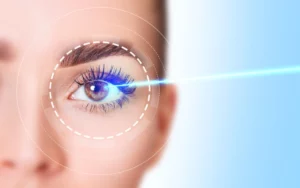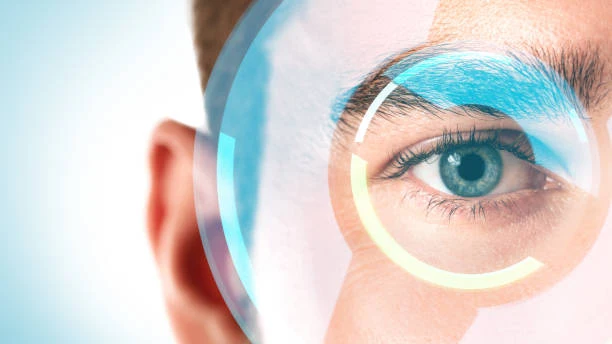LASIK surgery is a popular form of refractive eye surgery, commonly utilized to rectify vision problems including myopia (nearsightedness), hyperopia (farsightedness), and astigmatism. In this comprehensive guide, we delve deeper into the world of LASIK surgery, specifically focusing on Q-LASIK, a modern variation that provides highly individualized and effective results.
Contents
What is Q Lasik Laser?
 Q-LASIK laser is a variation of the traditional LASIK (Laser-Assisted In Situ Keratomileusis) procedure, but it takes a significant leap forward. It incorporates wavefront technology and an advanced laser system to provide a treatment plan that is uniquely tailored to the individual’s eye.
Q-LASIK laser is a variation of the traditional LASIK (Laser-Assisted In Situ Keratomileusis) procedure, but it takes a significant leap forward. It incorporates wavefront technology and an advanced laser system to provide a treatment plan that is uniquely tailored to the individual’s eye.
This sophisticated laser system employs a method called ‘wavefront-guided LASIK‘, which generates a 3D map of the patient’s eye. This map accounts for the intricate nuances of the eye’s anatomy and the specific manner in which light is refracted. By creating a more detailed map, the Q-LASIK laser can treat a wider range of refractive errors, including higher-order aberrations, which traditional LASIK may not adequately correct.
How Q-LASIK Works: A Step-by-Step Guide
- Wavefront Analysis: This initial step involves mapping the eye’s refractive errors using a wavefront analyzer. The process produces a 3D map of the eye, referred to as a ‘wavefront map’.
- Treatment Planning: Based on the wavefront map, a personalized treatment plan is devised. The plan takes into account the unique intricacies of the individual’s refractive errors.
- Corneal Flap Creation: Just like in traditional LASIK, a thin corneal flap is created using a microkeratome or a femtosecond laser.
- Corneal Reshaping: The surgeon uses an excimer laser to reshape the cornea according to the personalized treatment plan. The laser corrects refractive errors by removing microscopic layers of tissue.
- Flap Re-positioning: The corneal flap is then gently repositioned to its original location, where it adheres naturally without the need for stitches.
Estimated Cost of Q-LASIK in India
As of 2023, the average cost of Q-LASIK eye surgery in India can range between INR 30,000 to INR 1,00,000 per eye. It’s important to note that this is a rough estimate and the actual cost may vary depending on various factors.
Factors Influencing Q-LASIK Cost
The cost of Q-LASIK can vary based on a number of factors:
- Geographical Location: The cost of Q-LASIK in metropolitan cities may be higher due to increased operational costs. Smaller cities or towns might offer the procedure at a slightly lower cost.
- Surgeon’s Expertise: The experience and reputation of the surgeon can also impact the price. Renowned surgeons with a proven track record often charge more for their services.
- Technology Used: The type of laser technology and the equipment used can significantly affect the cost. State-of-the-art technology such as the wavefront-guided lasers used in Q-LASIK might contribute to a higher overall cost.
- Aftercare Services: Post-operative care, follow-up visits, and any necessary medications or additional services can also influence the total cost.
The Benefits of Q-LASIK
 Considering the investment required for Q-LASIK, it’s natural to wonder about its benefits and whether it’s worth it. Here are some of the advantages of this cutting-edge procedure and its potential value.
Considering the investment required for Q-LASIK, it’s natural to wonder about its benefits and whether it’s worth it. Here are some of the advantages of this cutting-edge procedure and its potential value.
- Individualized Treatment: Unlike traditional LASIK, Q-LASIK offers a tailored treatment plan based on the unique characteristics of your eye. This individualized approach enhances the precision of the procedure, leading to more accurate vision correction.
- Improved Visual Acuity: Q-LASIK’s ability to correct higher-order aberrations not only addresses the basic refractive errors but also improves overall visual quality. This can lead to clearer, sharper vision, even in dim light or night-time conditions.
- Rapid Recovery: Most patients experience significant improvement in their vision within a few days of the Q-LASIK procedure. The recovery process is typically quick, with minimal discomfort.
- Long-Lasting Results: With proper post-operative care and barring any changes related to age, the results of the Q-LASIK procedure can last for many years, or even a lifetime.
Common Side Effects Associated With It
 While Q-LASIK is a safe and efficient procedure, it’s essential to know the possible side effects and risks associated with it.
While Q-LASIK is a safe and efficient procedure, it’s essential to know the possible side effects and risks associated with it.
- Dry Eyes: Some patients may experience dry eyes after the Q-LASIK procedure. This can cause discomfort and blurred vision. Most cases are temporary, and the condition improves over time with the use of lubricating eye drops.
- Glare, Halos, and Double Vision: These visual disturbances can be experienced in low light conditions and are more common immediately after the surgery. Most patients find that these effects diminish and often disappear entirely within a few weeks or months.
- Fluctuating Vision: Some people might notice fluctuating vision for a few days or weeks after the surgery. This is typically a part of the healing process.
- Temporary Discomfort: Immediately following the procedure, some patients may experience mild discomfort, itching, or a burning sensation. This usually subsides within a few hours.
- Corneal Infection: As with any surgical procedure, there is a small risk of infection. Timely diagnosis and treatment are critical to managing this rare occurrence.
- Corneal Haze: In rare cases, patients can experience ‘corneal haze,’ which can cause blurry or hazy vision. This condition is less common with modern laser systems and is usually treatable.
While this advanced LASIK eye surgery has potential side effects, it’s important to remember that it is a safe and effective procedure for most patients. The possibility of experiencing side effects should be weighed against the potential benefits.
Conclusion
In conclusion, Q-LASIK eye surgery is a significant step forward in the field of refractive eye surgery, offering an unprecedented level of precision and customization. With its ability to provide individualized treatment, superior visual quality, and potentially fewer side effects, this advanced LASIK surgery represents a transformative option for those seeking clear vision.
It is a safe 10-minute procedure to help you get rid of glasses. EyeMantra offers the most advanced LASIK options including PRK, Femto Lasik, SMILE surgery, Standard LASIK, ICL, and Contoura vision. If you have any questions on Lasik surgery in Delhi, Lasik surgery cost, and Lasik procedure, call us at 9711116605 or email at [email protected].
FAQ’s
1. Is Q-LASIK Painful?
During the Q-LASIK eye surgery, your surgeon applies anesthetic eye drops to numb your eye, ensuring you feel little to no pain. You might feel slight pressure or mild discomfort, but most patients do not consider the procedure painful. You can use pain relievers and lubricating eye drops to ease any discomfort.
2. Is Q-LASIK Safe?
Yes, Q-LASIK is considered a safe procedure for vision correction. It uses advanced wavefront technology and a precise laser system to ensure accurate vision correction tailored to the individual’s eye. Like any surgical procedure, it does have potential risks and side effects, but these are generally rare and manageable.
3. How Long is Recovery from Q-LASIK?
Typically, many patients can return to their normal activities within a day or two. However, it’s crucial to follow all post-operative care instructions provided by your ophthalmologist to ensure a smooth recovery and optimal results.


